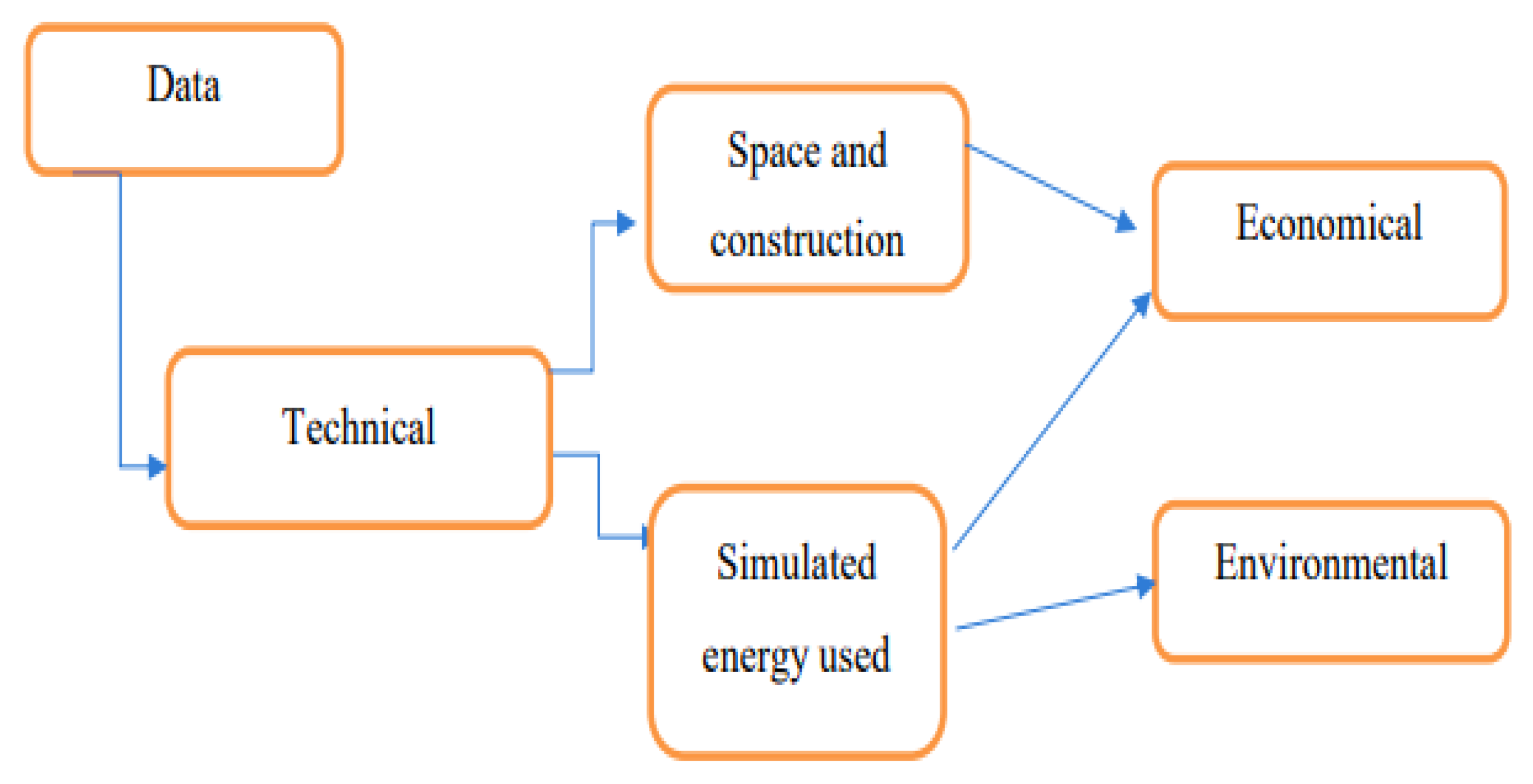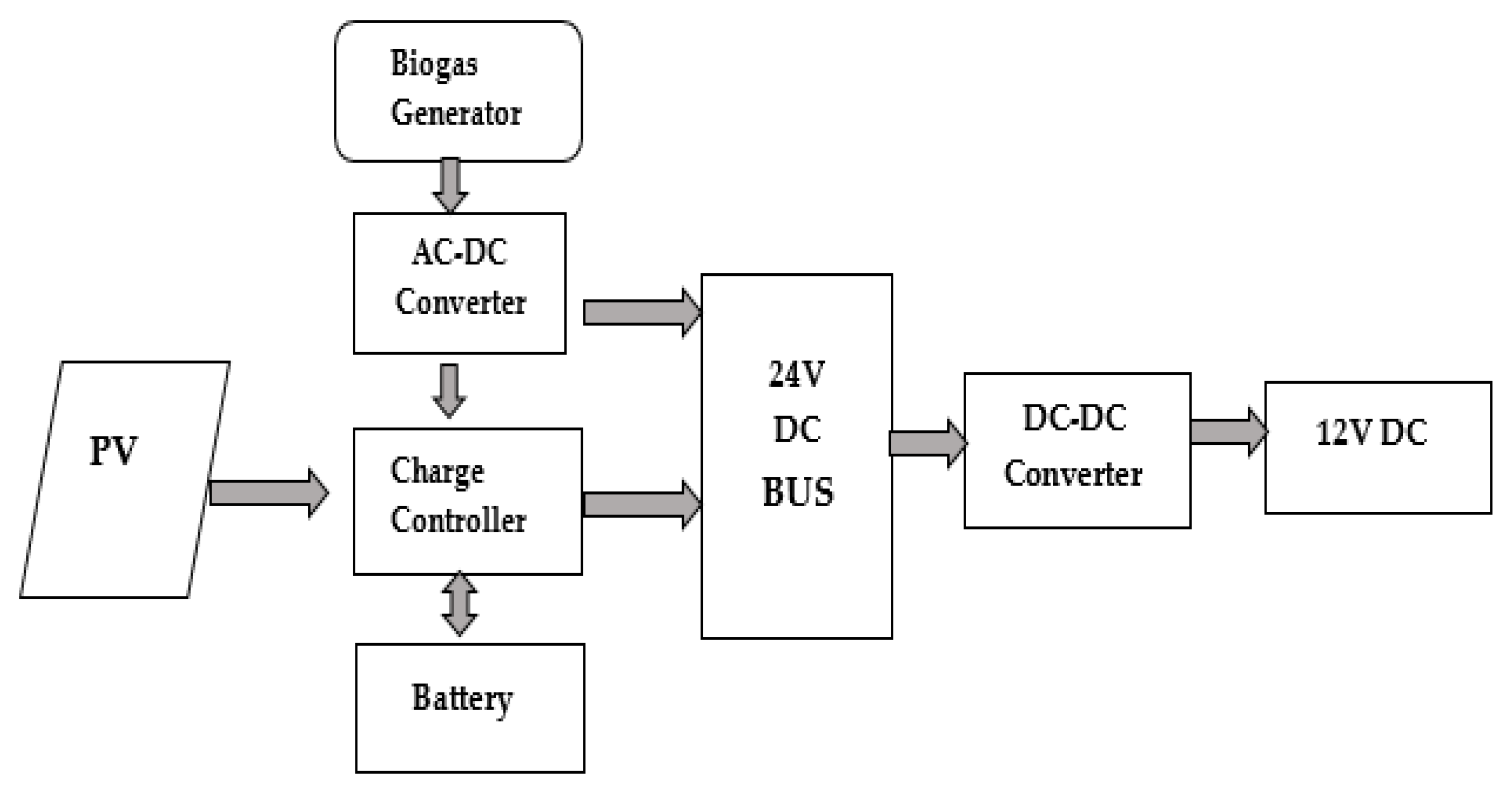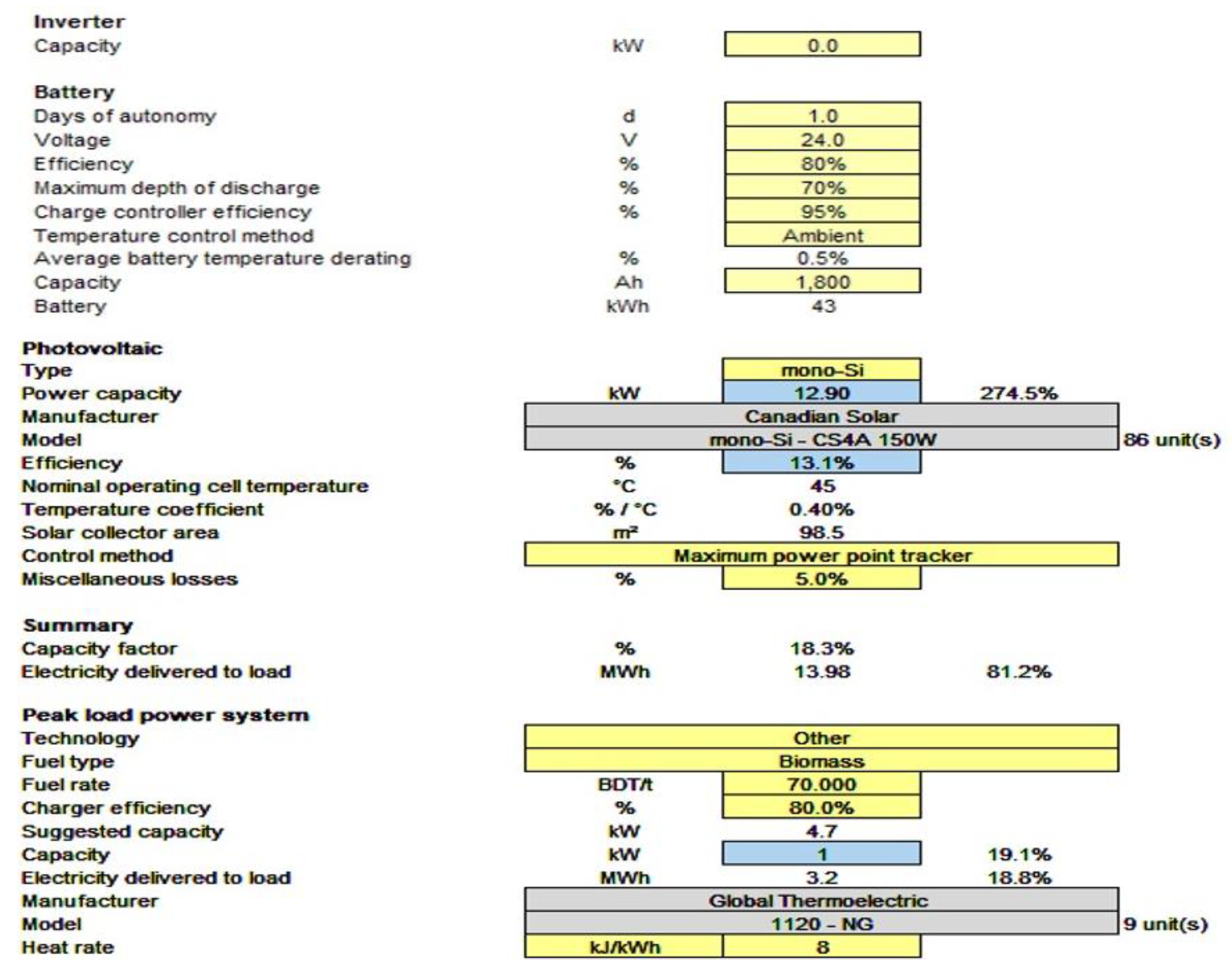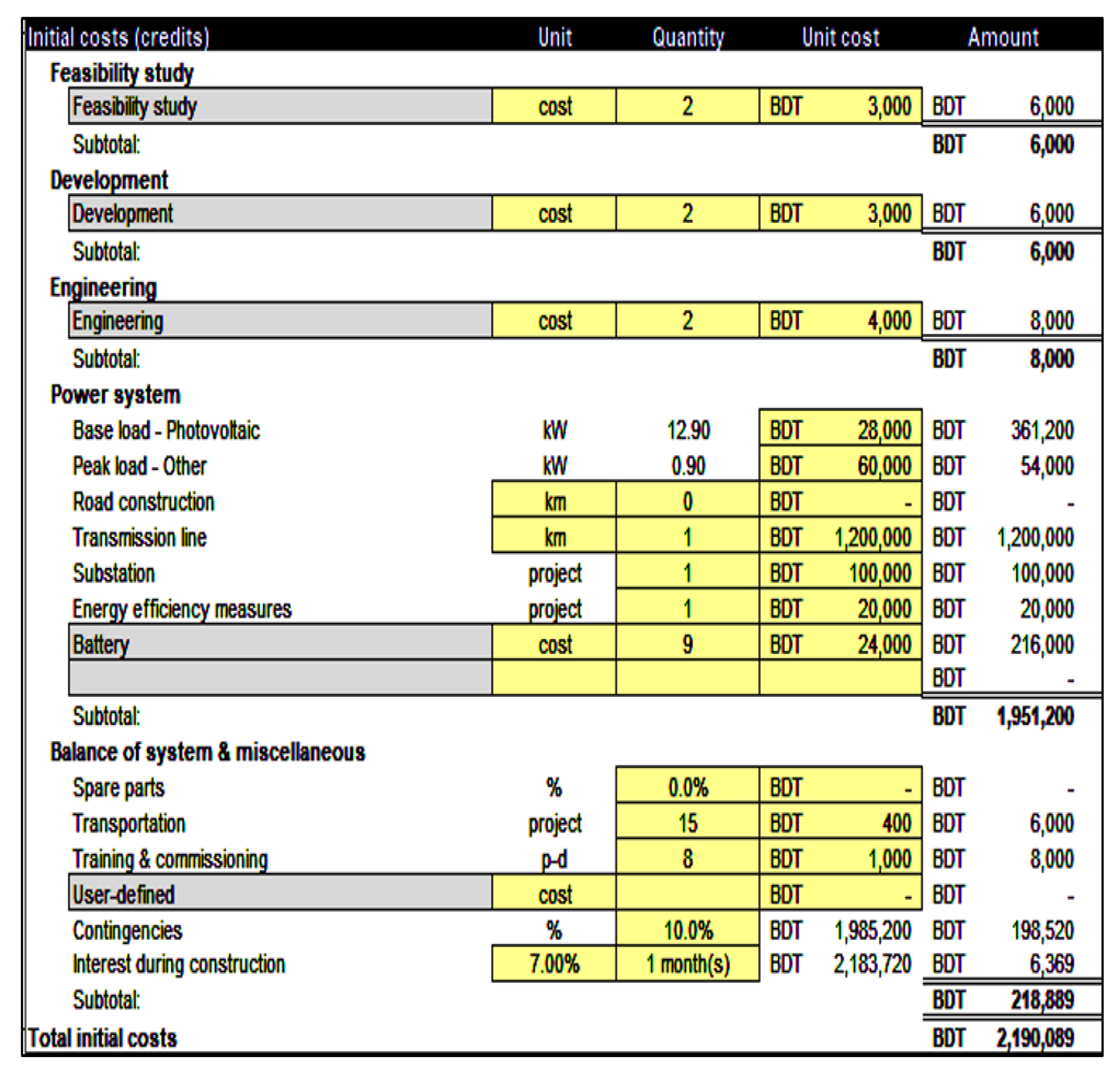Feasibility and Cost Analysis of Photovoltaic-Biomass Hybrid Energy System in Off-Grid Areas of Bangladesh
Abstract
:1. Introduction
2. Project Location and Simulation Methods
2.1. Simulation Method
2.2. Load Profile and Climate Data of Project Location
3. The Proposed PV-Biomass Hybrid System
4. Results and Discussion
4.1. Base Case Power Study
4.2. Proposed Case Power Study
4.3. Cost Analysis
4.4. Financial Viability & Cumulative Cash Flow Analysis
4.5. Emissions Analysis
5. Conclusions
Author Contributions
Funding
Conflicts of Interest
References
- Pasetti, M.; Rinaldi, S.; Manerba, D. A Virtual Power Plant Architecture for the Demand-Side Management of Smart Prosumers. Appl. Sci. 2018, 8, 432. [Google Scholar] [CrossRef] [Green Version]
- Rinaldi, S.; Pasetti, M.; Sisinni, E.; Bonafini, F.; Ferrari, P.; Rizzi, M.; Flammini, A. On the Mobile Communication Requirements for the Demand-Side Management of Electric Vehicles. Energies 2018, 11, 1220. [Google Scholar] [CrossRef] [Green Version]
- Zomers, A. The challenge of rural electrification. Energy Sustain. Dev. 2003, 7, 69–76. [Google Scholar] [CrossRef]
- Alavi, S.M. Techno-Economic Pre-Feasibility Study of Wind and Solar Electricity Generating Systems for Households in Central Finland. Master’s Thesis, University of Jyväskylä, Jyväskylä, Finland, 2014. [Google Scholar]
- Taniguchi, M.; Kaneko, S. Operational performance of the Bangladesh rural electrification program and its determinants with a focus on political interference. Energy Policy 2009, 37, 2433–2439. [Google Scholar] [CrossRef] [Green Version]
- Islam, A.; Chan, E.S.; Taufiq-Yap, Y.H.; Mondal, M.A.H.; Moniruzzaman, M.; Mridha, M. Energy security in Bangladesh perspective—An assessment and implication. Renew. Sustain. Energy Rev. 2014, 32, 154–171. [Google Scholar] [CrossRef]
- Mandelli, S.; Barbieri, J.; Mereu, R.; Colombo, E. Off-grid systems for rural electrification in developing countries: Definitions, classification and a comprehensive literature review. Renew. Sustain. Energy Rev. 2016, 58, 1621–1646. [Google Scholar] [CrossRef]
- Bhattacharyya, S.C.; Palit, D. Mini-grid based off-gridelectrification to enhance electricity access in developing countries: What policies may be required? Energy Policy 2016, 94, 166–178. [Google Scholar] [CrossRef] [Green Version]
- Kobos, P.H.; Erickson, J.D.; Drennen, T.E. Technological learning and renewable energy costs: Implications for US renewable energy policy. Energy Policy 2006, 34, 1645–1658. [Google Scholar] [CrossRef]
- Nguyen, K.Q. Alternatives to grid extension for rural electrification: Decentralized renewable energy technologies in Vietnam. Energy Policy 2007, 35, 2579–2589. [Google Scholar] [CrossRef]
- Longo, M.; Hossain, C.A.; Roscia, M. Smart Mobility for Green University Campus. In Proceedings of the Asia-Pacific Power and Energy Engineering Conference (APPEEC), Kowloon, China, 8–11 December 2013; pp. 1–6. [Google Scholar]
- Bernal-Agustín, J.L.; Dufo-López, R. Simulation and optimization of stand-alone hybrid renewable energy systems. Renew. Sustain. Energy Rev. 2009, 13, 2111–2118. [Google Scholar] [CrossRef]
- Ho, W.S.; Hashim, H.; Hassim, M.H.; Muis, Z.A.; Shamsuddin, N.L.M. Design of distributed energy system through Electric System Cascade Analysis (ESCA). Appl. Energy 2012, 99, 309–315. [Google Scholar] [CrossRef]
- Chowdhury, N.; Hossain, C.A.; Longo, M.; Yaïci, W. Optimization of solar energy system for the electric vehicle at university campus in Dhaka, Bangladesh. Energies 2018, 11, 2433. [Google Scholar] [CrossRef] [Green Version]
- Dedé, A.; Della Giustina, D.; Massa, G.; Pasetti, M.; Rinaldi, S. A Smart PV Module with Integrated Electrical Storage for Smart Grid Applications. In Proceedings of the IEEE International Symposium on Power Electronics, Electrical Drives, Automation and Motion (SPEEDAM), Anacapri, Italy, 22–24 June 2016; pp. 895–900. [Google Scholar]
- Marchi, B.; Pasetti, M.; Zanoni, S. Life Cycle Cost Analysis for BESS Optimal Sizing. In Proceedings of the Energy Procedia, Special issue of the 2016 International Scientific Conference on Environmental and Climate Technologies (CONECT), Riga, Latvia, 12–14 October 2016; Volume 113, pp. 127–134. [Google Scholar]
- Marchi, B.; Zanoni, S.; Pasetti, M. A Techno-Economic Analysis of Li-ion Battery Energy Storage Systems in Support of PV Distributed Generation. In Proceedings of the 21st Summer School F. Turco of Industrial Systems Engineering, Naples, Italy, 13–15 September 2016; pp. 145–149. [Google Scholar]
- Marchi, B.; Pasetti, M.; Zanoni, S.; Zavanella, L.E. The Italian Reform of Electricity Tariffs for Non Household Customers: The Impact on Distributed Generation and Energy Storage. In Proceedings of the 22nd Summer School F. Turco of Industrial Systems Engineering, Palermo, Italy, 13–15 September 2017; pp. 103–109. [Google Scholar]
- Hossain, C.A.; Chowdhury, N.; Longo, M.; Yaïci, W. System and Cost Analysis of Stand-Alone Solar Home System Applied to a Developing Country. Sustainability 2019, 11, 1403. [Google Scholar] [CrossRef] [Green Version]
- Khan, M.J.; Iqbal, M.T. Pre-feasibility study of stand-alone hybrid energy systems for applications in Newfoundland. Renew. Energy 2005, 30, 835–854. [Google Scholar] [CrossRef]
- Akella, A.K.; Sharma, M.P.; Saini, R.P. Optimum utilization of renewable energy sources in a remote area. Renew. Sustain. Energy Rev. 2007, 11, 894–908. [Google Scholar] [CrossRef]
- Shaahid, S.M.; Elhadidy, M.A. Technical and economic assessment of grid-independent hybrid photovoltaic–diesel–battery power systems for commercial loads in desert environments. Renew. Sustain. Energy Rev. 2007, 11, 1794–1810. [Google Scholar] [CrossRef]
- Kenfack, J.; Neirac, F.P.; Tatietse, T.T.; Mayer, D.; Fogue, M.D.; Lejeune, A. Micro hydro–PV–hybrid system: Sizing a small hydro–PV–hybrid system for rural electrification in developing countries, technical note. Renew. Energy 2009, 34, 2259–2263. [Google Scholar] [CrossRef]
- Silva, S.B.; de Oliveira, M.A.G.; Severino, M.M. Economic evaluation and optimization of a photovoltaic–fuel cell–batteries hybrid system for use in the Brazilian Amazon. Energy Policy 2010, 38, 6713–6723. [Google Scholar] [CrossRef]
- Ma, T.; Yang, H.; Lu, L. A feasibility study of a stand-alone hybrid solar–wind–battery system for a remote island. Appl. Energy 2014, 121, 149–158. [Google Scholar] [CrossRef]
- Okedu, K.E.; Al-Hashmi, M. Assessment of the cost of various renewable energy systems to provide power for a small community: Case of Bukha, Oman. Int. J. Smart Grid 2018, 2, 3. [Google Scholar]
- Sepulveda, T.T.; Martinez, L. Optimization of a hybrid energy system for an isolated community in Brazil. Int. J. Renew. Energy Res. 2016, 6, 1476–1481. [Google Scholar]
- Bhattarai, P.R.; Thompson, S. Optimizing an off-grid electrical system in Brochet, Manitoba, Canada. Renew. Sustain. Energy Rev. 2016, 53, 709–719. [Google Scholar] [CrossRef] [Green Version]
- Lipu, M.S.H.; Hafiz, M.G.; Ullah, M.S.; Hossain, A.; Munia, F.Y. Design Optimization and Sensitivity Analysis of Hybrid Renewable Energy Systems: A case of Saint Martin Island in Bangladesh. Int. J. Renew. Energy Res. 2017, 7, 2. [Google Scholar]
- Brenna, M.; Longo, M.; Yaici, W.; Abegaz, T.D. Simulation and Optimization of Integration of Hybrid Renewable Energy Sources and Storages for Remote Communities Electrification. In Proceedings of the IEEE PES Innovative Smart Grid Technologies Conference Europe (ISGT-Europe), Torino, Italy, 26–29 September 2017. [Google Scholar]
- Longo, M.; Yaïci, W.; Foidelli, F. Hybrid Renewable Energy System with Storage for Electrification—Case Study of Remote Northern Community in Canada. Int. J. Smart Grid 2019, 3, 63–71. [Google Scholar]
- Ahmed, S.; Islam, M.T.; Karim, M.A.; Karim, N.M. Exploitation of renewable energy for sustainable development and overcoming power crisis in Bangladesh. Renew. Energy 2014, 72, 223–235. [Google Scholar] [CrossRef]
- Islam, M.T.; Shahir, S.A.; Uddin, T.M.I.; Saifullah, A.Z.A. Current energy scenario and future prospect of renewable energy in Bangladesh. Renew. Sustain. Energy Rev. 2014, 39, 1074–1088. [Google Scholar] [CrossRef]
- Kanagawa, M.; Nakata, T. Assessment of access to electricity and the socio-economic impacts in rural areas of developing countries. Energy Policy 2008, 36, 2016–2029. [Google Scholar] [CrossRef]
- Siddaiah, R.; Saini, R.P. A review on planning, configurations, modeling and optimization techniques of hybrid renewable energy systems for off grid applications. Renew. Sustain. Energy Rev. 2016, 58, 376–396. [Google Scholar] [CrossRef]
- Guo, S.; Liu, Q.; Sun, J.; Jin, H. A review on the utilization of hybrid renewable energy. Renew. Sustain. Energy Rev. 2018, 91, 1121–1147. [Google Scholar] [CrossRef]
- Islam, M.S.; Akhter, R.; Rahman, M.A. A thorough investigation on hybrid application of biomass gasifier and PV resources to meet energy needs for a northern rural off-grid region of Bangladesh: A potential solution to replicate in rural off-grid areas or not? Energy 2018, 145, 338–355. [Google Scholar] [CrossRef]
- Murugaperumala, K.; Vimal Raj, P.A.D. Feasibility design and techno-economic analysis of hybrid renewable energy system for rural electrification. Sol. Energy 2019, 188, 1068–1083. [Google Scholar] [CrossRef]
- Rad, M.A.V.; Ghasempour, R.; Rahdan, P.; Mousavi, S.; Arastounia, M. Techno-economic analysis of a hybrid power system based on the cost-effective hydrogen production method for rural electrification, a case study in Iran. Energy 2020, 190, 116421. [Google Scholar] [CrossRef]
- Tanim, M.M.; Chowdhury, N.A.; Rahman, M.M.; Ferdous, J. Design of a Photovoltaic-Biogas Hybrid Power Generation System for Bangladeshi Remote area Using HOMER Software. In Proceedings of the 2014 3rd International Conference on the Developments in Renewable Energy Technology ICDRET, Dhak, Bangladesh, 29–31 May 2014. [Google Scholar]
- Habib, M.A.; Chungpaibulpatana, S. Utilization of Solar and Biomass for Rural Electrification in Bangladesh. In Proceedings of the 2014 International Conference and Utility Exhibition on Green Energy for Sustainable Development ICUE, Pattaya City, Thailand, 19–21 March 2014. [Google Scholar]
- Ahsan-Uz-Zaman, K.M.; Wahed, A.; Sayam, A.S.M.; Faruk, O.; Sarker, B.C. Solar-Biomass Hybrid System, an Approach for Rural Electrification in Bangladesh. In Proceedings of the 4th International Conference on Electrical Engineering and Information and Communication Technology iCEEiCT, Dhaka, Bangladesh, 13–15 September 2018; pp. 187–192. [Google Scholar]
- Das, B.K.; Hoque, N.; Mandal, S.; Pal, T.K.; Raihan, M.A. A techno-economic feasibility of a stand-alone hybrid power generation for remote area application in Bangladesh. Energy 2017, 134, 775–788. [Google Scholar] [CrossRef]
- Khan, E.U.; Mainali, B.; Martin, A.; Silveira, S. Techno-economic analysis of small scale biogas based polygeneration systems: Bangladesh case study. Sustain. Energy Technol. Assess. 2014, 7, 68–74. [Google Scholar] [CrossRef]
- Mandal, S.; Das, B.K.; Hoque, N. Optimum sizing of a stand-alone hybrid energy system for rural electrification in Bangladesh. J. Clean Prod. 2018, 200, 12–27. [Google Scholar] [CrossRef]
- Natural Resources Canada, RETScreen Data Analysis Software and Modelling Tool. Available online: https://www.nrcan.gc.ca/energy/software-tools/7465 (accessed on 15 January 2020).
- Afzal, A. Performance Analysis of Integrated Wind, Photovoltaic and Biomass Energy Systems. In Proceedings of the World Renewable Energy Congress 2011, Linköping, Sweden, 8–13 May 2011; pp. 818–825. [Google Scholar]
- Liqun, L.; Chunxia, L. Feasibility analyses of hybrid wind-PV-battery power system in Dongwangsha, Shanghai. Przegląd Elektrotechniczny 2013, 89, 239–242. [Google Scholar]
- Kalinchyk, I.; Pfeiffer, C.F.; Inshekov, E. RETScreen Modeling for Combined Energy Systems Fertilizers Plant Case. In Proceedings of the 55th Conference on Simulation and Modelling, Modelling, Simulation and Optimization (SIMS 55) 2014, Aalborg, Denmark, 21–22 October 2014; pp. 7–15. [Google Scholar]
- Hasan, M.M.; Chowdhury, N.; Hossain, C.A.; Longo, M. State of Art on Possibility & Optimization of Solar PV-Wind Hybrid System. In Proceedings of the 2019 International Conference on Robotics, Electrical and Signal Processing Techniques (ICREST), Dhaka, Bangladesh, 10–12 January 2019; pp. 598–601. [Google Scholar]
- Sinha, S.; Chandel, S.S. Review of software tools for hybrid renewable energy systems. Renew. Sustain. Energy Rev. 2014, 32, 192–205. [Google Scholar] [CrossRef]
- Dwivedy, D.; Singh, S.K.; Choudhury, M.K.; Pradhan, S.R. Study of Cost Analysis and Emission Analysis for Grid Connected PV Systems using RETSCREEN 4 Simulation Software. Int. J. Eng. Res. Technol. 2015, 4, 203–207. [Google Scholar]
- Wattblock; Witheridge, S.; Stegen, S. Comparison of Solar PV vs Solar Thermal Hot Water Systems to Provide Energy Solutions for Strata Buildings. Master’s Thesis, Griffith School of Engineering Griffith University, Mount Gravatt, Australia, 22 May 2017. [Google Scholar]
- Clean Energy Project Analysis: RETScreen Engineering & Cases Textbook. Available online: http://msessd.ioe.edu.np/wp-content/uploads/2017/04/Textbook-clean-energy-project-analysis.pdf (accessed on 15 January 2020).
- D’Adamo, I. The Profitability of Residential Photovoltaic Systems. A New Scheme of Subsidies Based on the Price of CO2 in a Developed PV Market. Soc. Sci. 2018, 7, 148. [Google Scholar] [CrossRef] [Green Version]
- Nam, H.; Mukai, K.; Konishi, S.; Nam, K. Biomass gasification with high temperature heat and economic assessment of fusion-biomass hybrid system. Fusion Eng. Des. 2019, 146, 1838–1842. [Google Scholar] [CrossRef]





| Daily Load Profile | ||||||
|---|---|---|---|---|---|---|
| Appliance | Type | Unit | Watt | Hour of Operation (h) | Total Power (W) | Total Energy Demand (Wh) |
| LED | DC | 4 | 6 | 8 | 24 | 192 |
| Fan | DC | 2 | 20 | 14 | 20 | 560 |
| TV | DC | 1 | 40 | 4 | 40 | 160 |
| Daily Demand for each house | 84 | 912 | ||||
| Daily Demand for 50 houses | 4.2 kW | 45.6 kWh | ||||
| Load Characteristics | ||
| Electricity-DC | Base Case | Proposed Case |
| Daily | 47.2 kWh | 47.2 kWh |
| Annual | 14.161 MWh | 14.161 MWh |
| Peak Load-Annual | 4.7 kW | |
| Percentage of Month Used | ||
| Month | Base Case | Proposed Case |
| January | 54% | 54% |
| February | 54% | 54% |
| March | 93% | 93% |
| April | 93% | 93% |
| May | 93% | 93% |
| June | 93% | 93% |
| July | 99% | 99% |
| August | 99% | 99% |
| September | 99% | 99% |
| October | 99% | 99% |
| November | 54% | 54% |
| December | 54% | 54% |
| Parameter | Unit | Climate Data Location | Project Location |
|---|---|---|---|
| Latitude | °N | 24.1 | 24.1 |
| Longitude | °E | 91.9 | 91.9 |
| Elevation | m | 14 | 14 |
| Heating design temperature | °C | 13 | |
| Cooling design temperature | °C | 30.9 | |
| Earth temperature amplitude | °C | 13.5 |
| Month | Ambient Air Temperature °C | Relative Humidity % | Daily Solar Radiation kWh/m2/d | Earth Temperature °C |
|---|---|---|---|---|
| January | 20.4 | 54.7 | 4.42 | 21.6 |
| February | 22.7 | 55.3 | 4.98 | 23.9 |
| March | 25.2 | 61.7 | 5.44 | 27 |
| April | 26.3 | 73.1 | 5.51 | 28.1 |
| May | 27.1 | 79.1 | 5.11 | 28.8 |
| June | 27.5 | 84.7 | 4.16 | 28.4 |
| July | 27.3 | 85.9 | 4.04 | 27.9 |
| August | 27.1 | 85.5 | 4.18 | 27.8 |
| September | 26.7 | 84.1 | 4.02 | 27.6 |
| October | 26 | 77.9 | 4.28 | 26.8 |
| November | 23.8 | 69.4 | 4.25 | 24.4 |
| December | 21.3 | 60.1 | 4.28 | 22.1 |
| Annual | 25.1 | 72.7 | 4.55 | 26.2 |
| Parameter | Value |
|---|---|
| Grid Type | Off-grid |
| Fuel type | Kerosene-L |
| Fuel rate | 65 BDT/L |
| Capacity | 4.7 kW |
| Heat rate | 8 kJ/kWh |
| Annual O& M cost | BDT 474,500 |
| Electricity rate-base case | 33.512 BDT/kWh |
| Total electricity cost | BDT 474,702 |
| Project Costs and Saving/Income Summary | |||
|---|---|---|---|
| Initial Cost | |||
| Feasibility study | 0.3% | BDT | 6000 |
| Development | 0.3% | BDT | 6000 |
| Engineering | 0.4% | BDT | 8000 |
| Power system | 89.1% | BDT | 1,951,200 |
| Balance of system & misc. | 10.0% | BDT | 218,889 |
| Total initial costs | 100% | BDT | 2,190,089 |
| Annual Costs & Debt Payments | |||
| O & M | BDT | 159,375 | |
| Fuel cost-proposed case | BDT | 0 | |
| Debt payments-25 yrs | BDT | 8321 | |
| Total Annual costs | BDT | 167,696 | |
| Periodic Costs (credits) | |||
| Battery-5 yrs | BDT | 403,200 | |
| Converter-10 yrs | BDT | 89,600 | |
| End of project life-cost | BDT | 376,832 | |
| Annual Savings and Income | |||
| Fuel cost-base case | BDT | 474,702 | |
| Total annual savings and income | BDT | 474,702 | |
| Base Case System GHG Summary (Baseline) | ||||||
| Fuel type | Fuel Mix % | CO2 emission factor Kg/GJ | CH4 emission factor Kg/GJ | N2O emission factor Kg/GJ | Fuel Consumption MWh | GHG emission factor tCO2/MWh |
| Kerosene | 100% | 73.9 | 0.0070 | 0.0020 | 0 | 0.269 |
| Total | 100% | 73.9 | 0.0070 | 0.0020 | 0 | 0.269 |
| Proposed Case System GHG Summary (Power Proposed Project) | ||||||
| Fuel type | Fuel Mix % | CO2 emission factor Kg/GJ | CH4 emission factor Kg/GJ | N2O emission factor Kg/GJ | Fuel Consumption MWh | GHG emission factor tCO2/MWh |
| Biomass | 0.1 | 0 | 0.032 | 0.004 | 0 | 0.007 |
| Solar | 99.9 | 0 | 0 | 0 | 14 | 0 |
| Total | 100% | 0 | 0 | 0 | 14 | 0 |
© 2020 by the authors. Licensee MDPI, Basel, Switzerland. This article is an open access article distributed under the terms and conditions of the Creative Commons Attribution (CC BY) license (http://creativecommons.org/licenses/by/4.0/).
Share and Cite
Chowdhury, N.; Akram Hossain, C.; Longo, M.; Yaïci, W. Feasibility and Cost Analysis of Photovoltaic-Biomass Hybrid Energy System in Off-Grid Areas of Bangladesh. Sustainability 2020, 12, 1568. https://doi.org/10.3390/su12041568
Chowdhury N, Akram Hossain C, Longo M, Yaïci W. Feasibility and Cost Analysis of Photovoltaic-Biomass Hybrid Energy System in Off-Grid Areas of Bangladesh. Sustainability. 2020; 12(4):1568. https://doi.org/10.3390/su12041568
Chicago/Turabian StyleChowdhury, Nusrat, Chowdhury Akram Hossain, Michela Longo, and Wahiba Yaïci. 2020. "Feasibility and Cost Analysis of Photovoltaic-Biomass Hybrid Energy System in Off-Grid Areas of Bangladesh" Sustainability 12, no. 4: 1568. https://doi.org/10.3390/su12041568







